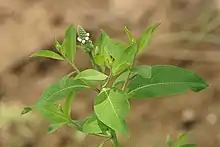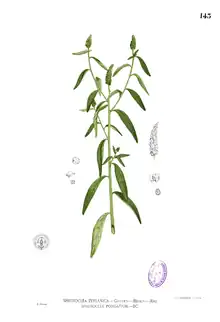| Sphenoclea zeylanica | |
|---|---|
 | |
| In bloom | |
 | |
| Botanical illustration | |
| Scientific classification | |
| Kingdom: | Plantae |
| Clade: | Tracheophytes |
| Clade: | Angiosperms |
| Clade: | Eudicots |
| Clade: | Asterids |
| Order: | Solanales |
| Family: | Sphenocleaceae |
| Genus: | Sphenoclea |
| Species: | S. zeylanica |
| Binomial name | |
| Sphenoclea zeylanica | |
| Synonyms[2] | |
|
List
| |
Sphenoclea zeylanica, called chickenspike, gooseweed, and wedgewort, is a widespread species of flowering plant in the genus Sphenoclea, native to Africa, Madagascar, tropical and subtropical Asia, and Australia.[3] It is widely introduced in the New World tropics and subtopics from the southern United States to northern Argentina.[2] Its young leaves are edible and are occasionally eaten, perhaps with a light boiling.[3] A common weed of rice paddies, it can cause yield losses from 25 to 50%.[4]
References
- ↑ Fruct. Sem. Pl. 1: 113 (1788)
- 1 2 "Sphenoclea zeylanica Gaertn". Plants of the World Online. Board of Trustees of the Royal Botanic Gardens, Kew. 2017. Retrieved 29 December 2020.
- 1 2 "Chickenspike (Sphenoclea zeylanica)". World Vegetable Center. AVRDC. 27 November 2020. Retrieved 29 December 2020.
eaten…with grated coconut
- ↑ Catindig, JLA; Lubigan, RT; Johnson, D (15 August 2017). "Sphenoclea zeylanica". irri.org. International Rice Research Institute. Retrieved 29 December 2020.
The dirty dozen
This article is issued from Wikipedia. The text is licensed under Creative Commons - Attribution - Sharealike. Additional terms may apply for the media files.